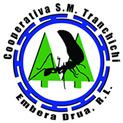|
Emebera
|
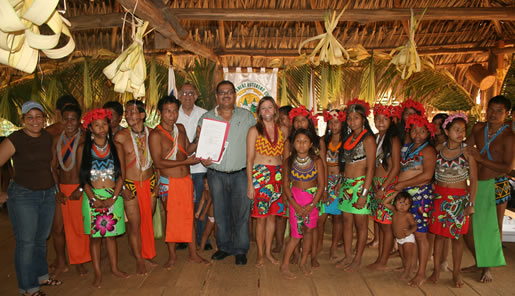
Tranchichi Tourism Cooperative received legal recognition, May 15, 2009
Origen: The Darien
Our community, Emberá Drúa, was founded April 25th, 1975. Initially Emberá Drúa was called 2.60, a named given by the Canal Commission. Today the community is known as Emberá Drúa, which in the Emberá dialect means “Place of the Emberá.”
The first individuals to settle in Emberá Drúa were Emiliano Caisamo, and his three sons and son-in-law: Adán, Alonso, Mamerto, and Elias Ruiz. They left the Darien Province in the 1970s in search of a better life near Panama City. The economic situation in the Darien had become very difficult and they could no longer make a good living from agriculture. Also, the clandestine groups of Colombian drug traffickers in the Darién were a great threat to their safety.
Emiliano Caisamo, our great-grandfather, was a man of humble means. He was a farmer, an expert in medicinal plants and a skilled artisan in the traditional Emberá carvings of cocobolo wood. His wife, Secundina Dequia, our great-grandmother, was a midwife. Together, they carved out a small, humble community in the jungle of the Upper Chagres. They practiced subsistence agriculture and hunting to sustain themselves and their family.

Our Tourism Project
In 1984, our family faced a new challenge to our traditional way of life. In this year, the area where we live, the Panama Canal watershed, became the Chagres National Park. Because of the new restrictions of living in a protected park, we had to look for new alternatives to our traditional activities of agriculture and hunting.
We started working in tourism in 1996. At first, we sought and received a lot of assistance from the Panama Tourism Bureau (IPAT), the World Bank, and several local Non-Governmental Organizations (NGOs).
They helped us get organized and build relationships with local tour operators. They also provided us important trainings in tourism, customer service and visitor safety.

Today
Today we have a very unique tourism program that is run by and supports our community. The contrast of tourists interacting in such a traditional setting may seem puzzling at first, but the program has actually strengthened our community in many ways.
Tourism is a means to earn the cash our families need to buy essential things like clothing, gasoline, and healthcare. And most importantly, it gives us the resources to send our children outside the village for secondary-school education.
Each one of us, child or adult, who participates in our community tourism earns a wage. The pay varies for each event, depending on the task (guide, cook, dancer, or boatman)..

Tranchini Emberá Drúa, R.L.
Our business is now a formalized cooperative, recognized by the Panamanian government. It is called "Tranchichi Emberá Drúa, R.L." Tranchichi is our name for leaf-cutter ants. If you've ever seen these ants marching along the forest floor carrying giant chunks of leaves to their nest, you would know that they are very hardworking and organized. Like us!
We are working very hard to grow our business tourism. We are learning about accounting, marketing and computers so we can run our new cooperative more efficiently. We are also learning English so that we can invite more independent tourists to visit us. And we are educating our children so that they can take over our business someday!
Tourism has turned out to be a really good choice for our community. It has low environmental impact, but has long-term sustainability. And most importantly for us, tourism has actually caused a renaissance in our traditional Emberá arts and culture. We are proud of who we are, and we are especially proud to share who we are with you, our visitors. It is you, our tourists, who support us in sustainably living this special way of life.
|
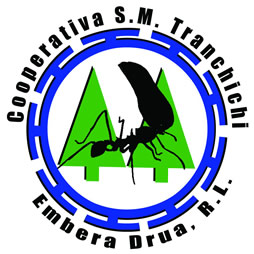
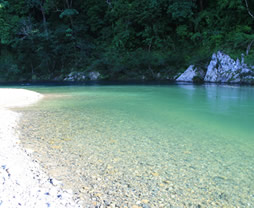
Our Pristine River
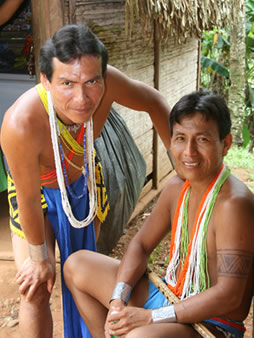
Our president of tourism and traditional Emberá chief
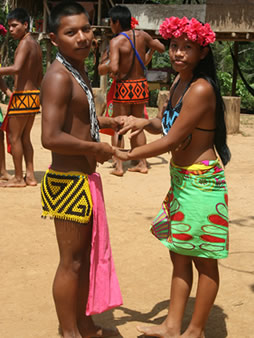
Emberá couple
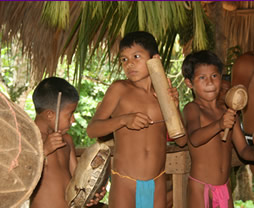
Emberá children playing traditional music |
